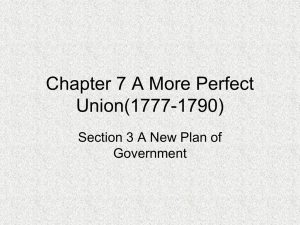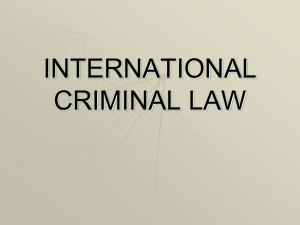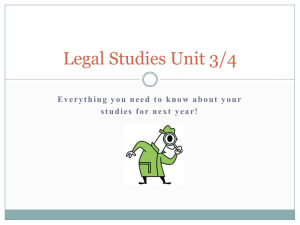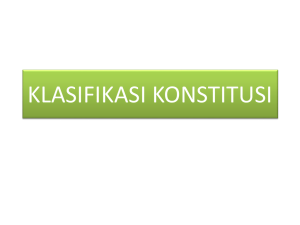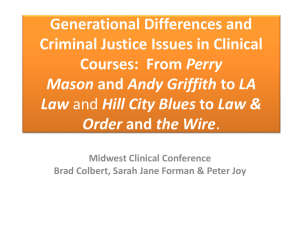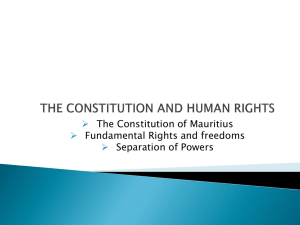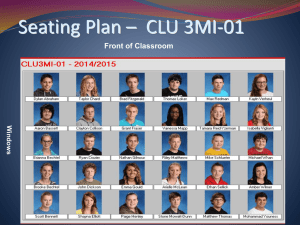STREET LAW - Capital High School
advertisement
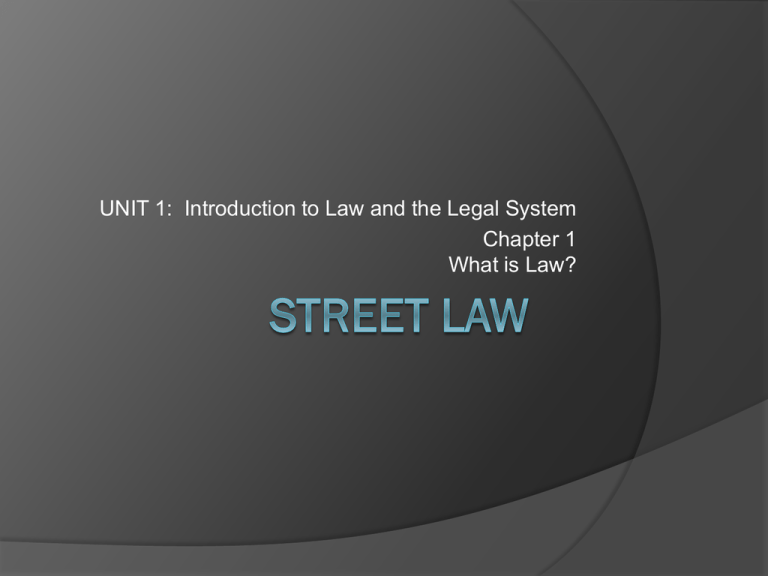
UNIT 1: Introduction to Law and the Legal System Chapter 1 What is Law? Unit 1 provides a foundation and frame of reference for the study of law In Chapter 1: Students learn the definition of law and the kinds of laws that exist Students then examine how law is related to values, human rights, and responsibilities within the framework of the U.S. Constitution Introduction Learning Outcomes—After completing this section, students should be able to: Define the term jurisprudence Explain several reasons for having laws Explain why the rule of law is important in a democratic society List a number of laws that affect daily life in our society Jurisprudence, or the study of law and legal philosophy, seeks to answer the question “What is law?” This field of study analyzes, explains, classifies, and criticizes bodies of law It also attempts to reveal the historical, moral, and cultural basis of a particular legal concept For Street Law, law is defined as: the rules made and enforced by government that regulate the conduct of people within a society Introduction Learning Outcomes—After completing this section, students should be able to: Define the term jurisprudence Explain several reasons for having laws Explain why the rule of law is important in a democratic society List a number of laws that affect daily life in our society Law is made by governments at the federal, state, local, or tribal levels Rules are made by private parties, i.e., schools, parents Laws are rules made by the government that tell people in a society how they should act While every society has some type of law, it can take many different forms depending on the given society Stable societies depend on government officials to enforce the laws and the citizens to obey them Laws and Values Learning Outcomes—After completing this section, students should be able to: Give examples of how laws reflect economic, moral, political, and social values List three essential aspects of a fully effective law Analyze a case in order to explore the relationship between law and morals Laws generally reflect people's ideas about right and wrong However, not everything that is immoral is illegal Laws often change over time as a society's values change One goal of the law in democratic societies is to respect the majority's wants while protecting the rights of those who have less of a voice in the system Caption Answer—p. 5 Economic values are often placed in conflict by environmental protection laws Caption Answer—p. 7 Allowing women in the military as pilots and other traditionally male-only positions reflects society’s changing ideas about gender equality Human Rights Learning Outcomes—After completing this section, students should be able to: Define the terms human rights, dignity, binding, covenant, and taking a reservation Identify the rights included in the Universal Declaration of Human Rights, the International Covenant on Civil and Political Rights, and the International Covenant on Economic, Social, and Cultural Rights Describe the extent to which the U.S. government recognizes and enforces international human rights agreements Identify and analyze examples of human rights violations in the United States and elsewhere in the world Human rights are the rights that belong to people simply because they are human beings Most countries have agreed to recognize and respect human rights by signing the Universal Declaration of Rights The United Nations has developed a system of international treaties that protects specific human rights Many countries also create laws aimed at protecting human rights Our Constitution, Bill of Rights, and other state and federal laws are all influenced by a desire to protect human rights Caption Answer—p. 9 Human rights can be used as standards when writing laws. Even though they may not refer to them as human rights, many laws contain provisions for protecting human rights Balancing Rights with Responsibilities Learning Outcomes—After completing this section, students should be able to: Evaluate the relationship between rights and responsibilities Identify reasons critics object to the United State’s emphasis on individual rights Distinguish between being right and having a right Americans enjoy many individual rights, but some people argue that these rights must be balanced with social responsibilities to foster a sense of community Caption Answer—p. 12 Many laws—such as voting laws and employment laws—have been extended to include women, minorities, and the disabled Kinds of Laws Learning Outcomes—After completing this section, students should be able to: Distinguish between the two major groups of laws: criminal and civil Define the terms criminal law, felony, misdemeanor, civil law, civil action, defendant, plaintiff, prosecutor, beyond a reasonable doubt, and preponderance of the evidence Explain the difference between criminal and civil laws Describe the difference between misdemeanors and felonies Recognize, from a story, the laws involved and identify each law as either civil or criminal Law can be divided into two major categories: civil and criminal Criminal laws regulate public conduct. In a criminal case, the government brings legal action against a person and imposes a penalty. Civil laws regulate relations between private individuals and may be enforced in a civil action by a private citizen (or group) who feels wronged. Sometimes the same act or wrong can be tried as both a civil and criminal case. However, criminal cases require a higher standard of evidence for conviction than civil cases, because the penalties are more severe. Caption Answer—p. 14 It is not likely that the public understood the difference between the criminal law and the civil law because many people were confused about how O.J. Simpson could be found not guilty of murder in the criminal case and liable for wrongful death in the civil case. Problem 1.7—p. 15 Transparency T1-2—“An Introduction to the Civil Justice and Criminal Justice Systems” a) Possible answers: skipping school taking the car ignoring the handicapped parking sign leaving trash on the park bench possessing illegal drug The following types of laws are involved in this story (b-c): Truancy—civil Unauthorized use of a motor vehicle—criminal Parking violation—criminal Licensing (street vendor)—criminal Warranty law (CD player)—civil Littering—criminal Tort of negligence—civil Breaking and entering—criminal Trespassing—civil or criminal Larceny—criminal Conversion of property—civil Search and seizure—criminal Possession of illegal substances—criminal Leaving the scene of an accident—criminal Arrest--criminal Our Constitutional Framework Learning Outcomes—After completing this section, students should be able to: Describe the function of the U.S. Constitution in defining and limiting the powers of government Define the terms limited government, separation of powers, statute, checks and balances, veto, judicial review, unconstitutional, federalism, and Bill of Rights Identify how powers of the executive, legislative, and judicial branches are separated by the Constitution Describe how checks and balances limit the power of government Describe how judicial review can be used to interpret the Constitution and protect individual rights Explain how the principle of limited government is reflected in the Bill of Rights Describe how and why constitutions may be amended Government & the Constitution Why do you think the Framers of the Constitution felt citizens needed protection from government? They wanted to avoid creating the kind of tyrannical government they had suffered under when they were controlled by the British government How does the Constitution protect American citizens from the government? The Bill of Rights contains a list of rights people have that limit what the government can do. For example: ○ The First Amendment begins with the phrase: “Congress shall make no law respecting . . . “ establishing a religion or prohibiting free exercise of religion, restricting the rights to free speech, press, petition, assembly, etc. Suppose there was just one branch of government rather than three Would there be any advantages to such an arrangement? ○ The government would be more efficient What kinds of problems would develop? ○ An unchecked branch might increase or abuse its power, threatening individual rights and the Constitution’s goals Suppose there was no system of checks and balances among the three branches of government What kinds of problems would citizens face? ○ Citizens might find their rights against the intrusion of government power limited Should constitutions be easier to amend than they are now? A constitution that is too easy to amend threatens a government’s stability A constitution that is too difficult to amend can become outdated Caption Answer—p. 16 The Constitution sets forth the basic framework of government It also lists the powers of the government, as well as the limits of these powers Activity—Determining the Constitutionality of Laws Working in pairs, decide if the following laws would be constitutional or unconstitutional—use the Bill of Rights as a reference [Handout] The United States Constitution is the highest law in the United States and the longest lasting written constitution in the world The United States Constitution sets forth guidelines for the organization of the government, lists the government's powers and limits, and outlines the freedoms of United States citizens The Constitution also designates that the federal government's power must be divided among three branches, each with distinct roles and checks on the other branches' power. In addition to federal power being shared among the three branches, power is also divided between the federal and state governments. Each state has its own constitution, which organizes its government and sets out the rights of its people. These constitutions, like the federal Constitution, are difficult to change, but amendment processes exist and are used when necessary. Problem 1.8—p. 18 a) The courts prevent the state from passing a law that violates the Constitution (checks and balances) and have the authority to invalidate such a law (judicial review) b) Congress regulates international affairs on behalf of the country, and a state regulates local issues limited within the state’s borders (federalism) c) The state court prevents the legislature from subjecting the prisoners to unconstitutional deprivation of rights (checks and balances) However, the court does not have the power to spend the money directly (separation of powers)


